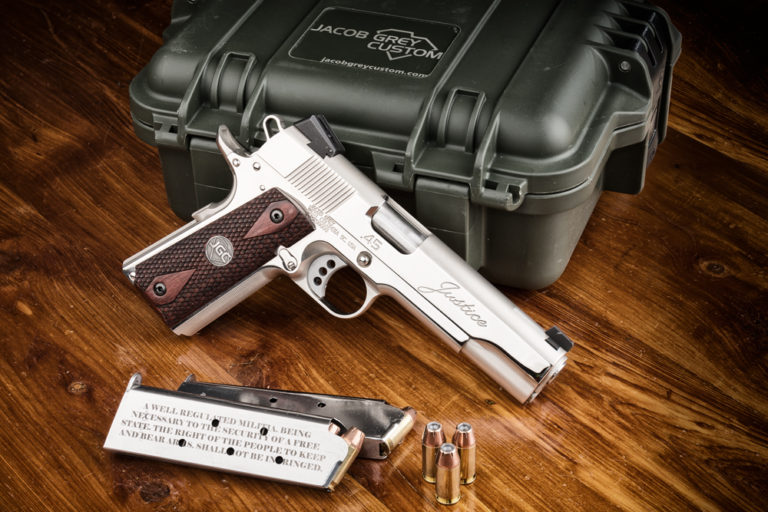
 Jacob Grey Custom pairs aerospace industry CNC machining with Browning’s classic design to create a precise and unique custom 1911.
Jacob Grey Custom pairs aerospace industry CNC machining with Browning’s classic design to create a precise and unique custom 1911.
As anyone familiar with the shooting sports well knows, there is a multitude of gun makers producing custom 1911s in varied styles, price ranges and with a wide array of features. If a person is so inclined, they can type the words “custom 1911” into their preferred search engine and scroll through pages upon pages of manufacturers—both large and small—all dedicated to crafting the perfect 1911.
The sheer number of different manufacturers is itself kind of inspiring. Ever since its development in the early 20th century, the 1911 has captured and held the interest of the shooting world, occupying an especially reverential place among American shooters. That so many gun makers throughout the country, and of various sizes and means, choose to focus on this classic design is perhaps the ultimate proof of its iconic status.
But, as can be seen in the market for AR-style rifles, this abundance of manufacturers inevitably results in oversaturation. With so many different choices, buyers may have difficulty navigating the crowded market. Similarly, some manufacturers with excellent products may be lost in the sea of competitors. Custom 1911 manufacturers need to have a product that stands out among the rest, and this is especially true for the smaller-scale operations.
One such manufacturer, Jacob Grey Custom, located in West Columbia, South Carolina, is doing just that by producing quality, custom 1911s in a unique way.
The Perfect Fit
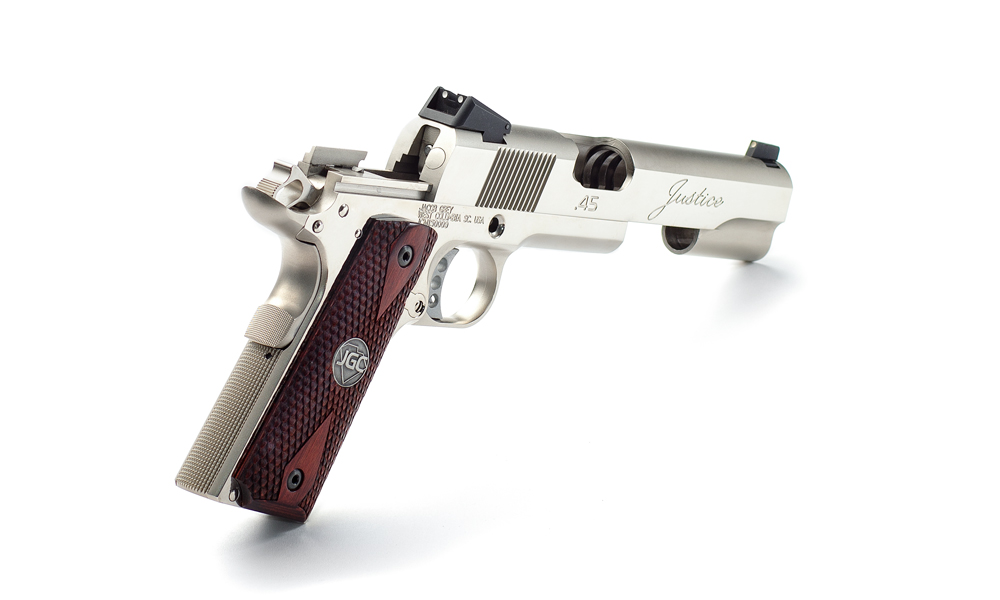
A relative newcomer to the gun making industry, Jacob Grey Custom was officially formed in 2011, with 1911 development and production first beginning in 2012. Founder Jake Brackett (the company’s name comes from his first and middle name, Jacob Grey), like his father before him, had worked in the machine shop industry for most of his life, and he had already been running an aerospace machining business for several years before the start of Jacob Grey Custom.
As Brackett tells it, his father had suggested he use the sophisticated CNC machines to try and make a precise 1911. Brackett, who was occupied with the aerospace business, put the suggestion off, but as an avid shooter it remained etched in the back of his mind. After some time, his father issued a bet, and that—not to mention a little bit of open machine time in the shop and an available engineer to help write up some programs—was all it took to get the ball rolling.
Several years and a fair amount of work later, this precise, aerospace-grade CNC machining process is at the heart of every 1911 Jacob Grey Custom produces. The advantage of using these exacting 5- and 7-axis CNC machines, Brackett says, is that they can meet stricter tolerances and get a very precise fit without the use of tools.
“In the aerospace industry, the only way to make something is to make it perfect,” Brackett said. “When I build the 1911, I don’t have to hit my guns with a hammer. You can watch videos of some of the other manufacturers, and they’ll make them where the slide and the frame don’t fit, and they will knock it on there using Ajax or some type of agent until they get what they call a “perfect fit.” You can get a perfect fit with a CNC machine because I can hold two-tenths tolerances, and two-tenths is your hair split four times.”
 Because of this precision, Jacob Grey Custom is able to get exceptionally tight slide-to-frame fits on its 1911s, as well as excellent lock-up between the slide and the barrel. According to Brackett, side-to-side movement on the slide-to-frame fit is less than a thousandth of an inch, and he places lock-up on the barrel and slide somewhere between 60 to 80 thousandths of an inch.
Because of this precision, Jacob Grey Custom is able to get exceptionally tight slide-to-frame fits on its 1911s, as well as excellent lock-up between the slide and the barrel. According to Brackett, side-to-side movement on the slide-to-frame fit is less than a thousandth of an inch, and he places lock-up on the barrel and slide somewhere between 60 to 80 thousandths of an inch.
In addition to having a precision fit, these guns are also built for longevity. This starts with using quality materials: U.S. sourced 4140 steel or 416 stainless billet, depending on the model. No forgings or cast materials are ever used, as Brackett states that, over time, the integrity of those can falter and cracks can form. After that, it comes down to how the parts are machined.
“In the machining process, we take precautions to ensure the future of the gun,” said Dusty Brackett, Jake’s brother and vice president of marketing and sales. “In all of our machining, all of our cutting is done in the same way so the stress and grain of the metal is not violated, and that carries on into the future because it helps us alleviate the possibility of stress fractures and fissures and cracks as the gun is used over time.”
Keeping in line with their aerospace machining approach, once the parts have been machined, they also fluorescent penetrant inspect (FPI) the metal for defects and use a coordinate-measuring machine (CMM) to ensure every part falls completely within their specifications.
The result of this process is a durable, incredibly tight-fitting and precise 1911, and apart from the stunning appearance of the gun itself, this is the first thing you notice when you bring a Jacob Grey Custom 1911 to hand.
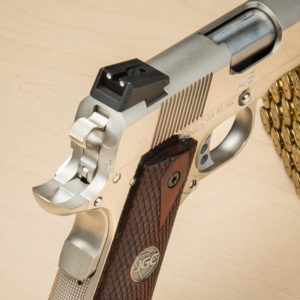
Functional Elegance
Jacob Grey Custom produces three different full-size 1911 models: the Liberty ($3,900), the Justice ($4,900) and the Revolution ($5,900)—a 3.5-inch barrel carry version is also in the works. The Liberty and the Justice are both machined from 4140 billet steel, while the Revolution is made from 416 stainless steel and has a chrome-plated finish. The Liberty model features a Cerakote finish, while the Justice typically comes with a master blued finish. All of the finishing, aside from the in-house Cerakoting, is done by Ford’s Guns, a custom finishing shop out of Florida.
For this review, I was sent the Justice model. However, unlike previous Justice 1911s, this was the company’s first to feature a nickel-plated finish instead of the classic blued.
The nickel-plated Justice makes a great first impression, and I’ve been told there have been several orders for the nickel finish since this one was produced. The gun’s frame sports classy, double-diamond wooden checkered grips and stylish yet functional front and rear strap checkering. The checkering on the rear of the frame is slightly more aggressive for secure purchase, while checkering on the front strap and the beavertail grip safety is less intense at 30 lines per inch (LPI).
The slide incorporates minimal cocking serrations at the rear and, apart from the company’s logo, the model name and caliber marking, it has no other engravings. This is a nice change from some custom 1911s that feature extensive engraving and scrollwork and provides a clean, elegant look.

The handgun features a thumb safety that is easy to locate and engage/disengage, as well as a lightly textured magazine release in the standard position just behind the trigger guard. Up top, the gun wears genuine Novak Tritium sights with an adjustable rear. Internally, the Justice 1911 utilizes a 5-inch match-grade barrel and matching bushing manufactured by Wilson Combat. This is one of the few areas, along with finishing, that Jacob Grey doesn’t produce in house. It also features a tuned, aluminum three-hole trigger, which breaks cleanly at 4.5 pounds, and a hand-polished feed ramp.
The gun ships with two magazines, one of which includes an inscription of the Second Amendment, inside of a rugged, foam-lined Pelican hard case. As a further reminder of this gun’s elegance, the Justice also comes with a display case made from gorgeous African Padauk wood.
At the range, I had the chance to put all the Justice’s ample features to the test with five loads from four different manufacturers: Hornady’s Critical Duty 220-grain FlexLock and American Gunner 185-grain XTP, SIG Sauer’s 185-grain V-Crown JHP, Aguila Ammunition’s 230-grain FMJ, and Winchester’s 230-grain FMJ. Accuracy testing took place at 15 yards from a rest using the pistol’s iron sights. Best and average groupings were taken from three, five-shot groups. Velocity measurements were taken using a Competition Electronics ProChrono chronograph from Brownells, placed approximately 10 feet from the muzzle.
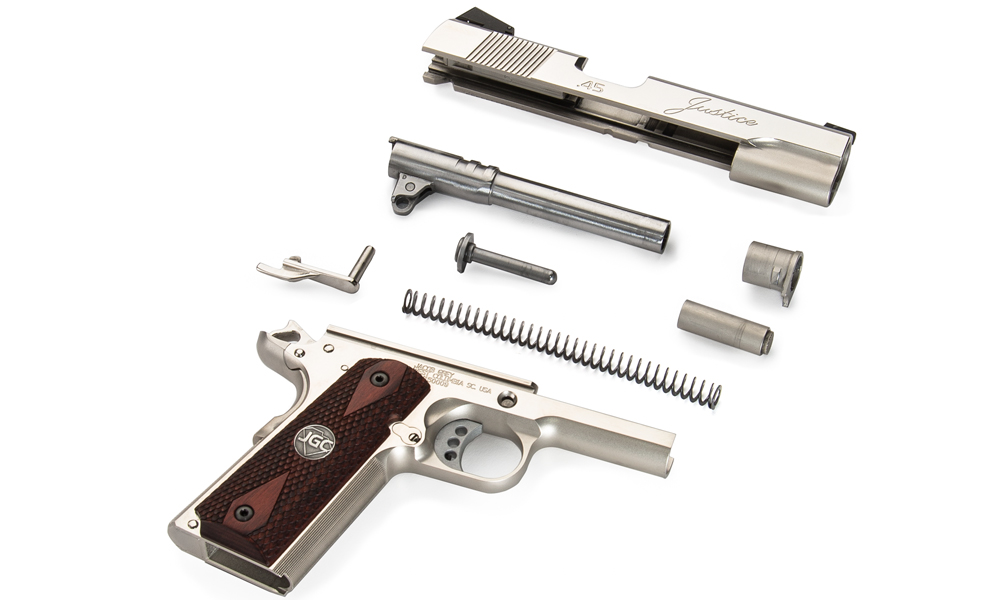
According to its website, Jacob Grey Custom lists mechanical accuracy for its pistols with groupings of 1.5 inches at 50 yards, an impressive feat for any handgun. This is in an optimal, stable environment and with the use of a Ransom Rest, which I did not have for testing. My groupings, therefore, are not fully representative of the Justice 1911’s true capabilities but rather are more indicative of what a relatively average shooter can expect to achieve.
Of the loads tested for this review, the 185-grain Hornady American Gunner XTP produced the best result for me, with a best group of about 2.5 inches. Meanwhile, I was able to achieve the best average group with the Winchester 230-grain FMJ loads at a little more than 3 inches. A friend of mine, who’s a bit more accomplished handgun shooter, was able to get a 2-inch group with the SIG Sauer V-Crown and a 1.81-inch group with one of his handloads. Average velocities for the different loads varied from 791 feet per second (fps) with the Aguila Ammo 230-grain FMJ at the low end to 1,025 fps with the SIG 185-grain V-Crown JHP at the high end.
In addition to standard accuracy testing from a rest position, I also engaged a host of steel targets, ranging from plates at 15-20 yards to a larger gong at 50 yards. The Justice 1911 ran smoothly and was a joy to shoot, making short work of the targets.
Parting Shots

At $4,900, the Jacob Grey Custom Justice 1911 certainly isn’t for everyone. It’s a high-end 1911 built for high-end buyers. But with anywhere between 100 to 150 machining and hand assembly hours going into each gun, that price is hard earned. And those many hours of production result in a precise, sophisticated 1911 that shoots well and feels completely natural in the hand. Racking the slide is ball-bearing smooth, and there’s essentially no side-to-side movement at all—truly something that has to be experienced to be fully understood.
The folks at Jacob Grey Custom know the prices on their guns place them out of reach for many shooters, but they also know they produce a great custom gun that performs at a high level and is one that shooters can use and still pass along to their children when the time comes.
“I just want somebody who wants a damn good gun that’s been built on an aerospace machine,” Jake Brackett said. “It’s accurate, it’s not going to fail, and it’s going to last a lifetime because of the way it’s made.”
This article is an excerpt from the Summer 2016 issue of Gun Digest the Magazine.

Next Step: Get your FREE Printable Target Pack
Enhance your shooting precision with our 62 MOA Targets, perfect for rifles and handguns. Crafted in collaboration with Storm Tactical for accuracy and versatility.
Subscribe to the Gun Digest email newsletter and get your downloadable target pack sent straight to your inbox. Stay updated with the latest firearms info in the industry.

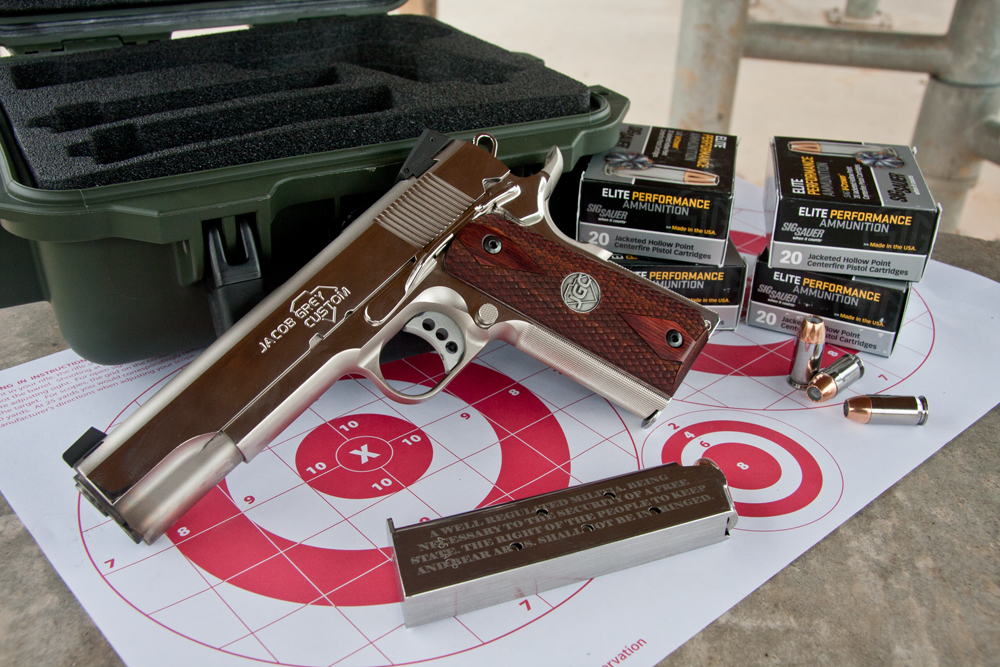
![Best Concealed Carry Guns In 2025 [Field Tested] Wilson Combat EDC X9S 1](https://gundigest.com/wp-content/uploads/Wilson-Combat-EDC-X9S-1-324x160.jpg)


![Best 9mm Carbine: Affordable PCCs [Tested] Ruger Carbine Shooting](https://gundigest.com/wp-content/uploads/Ruger-Carbine-Shooting-100x70.jpg)
![Best AR-15: Top Options Available Today [Field Tested] Harrington and Richardson PSA XM177E2 feature](https://gundigest.com/wp-content/uploads/Harrington-and-Richardson-PSA-XM177E2-feature-100x70.jpg)
